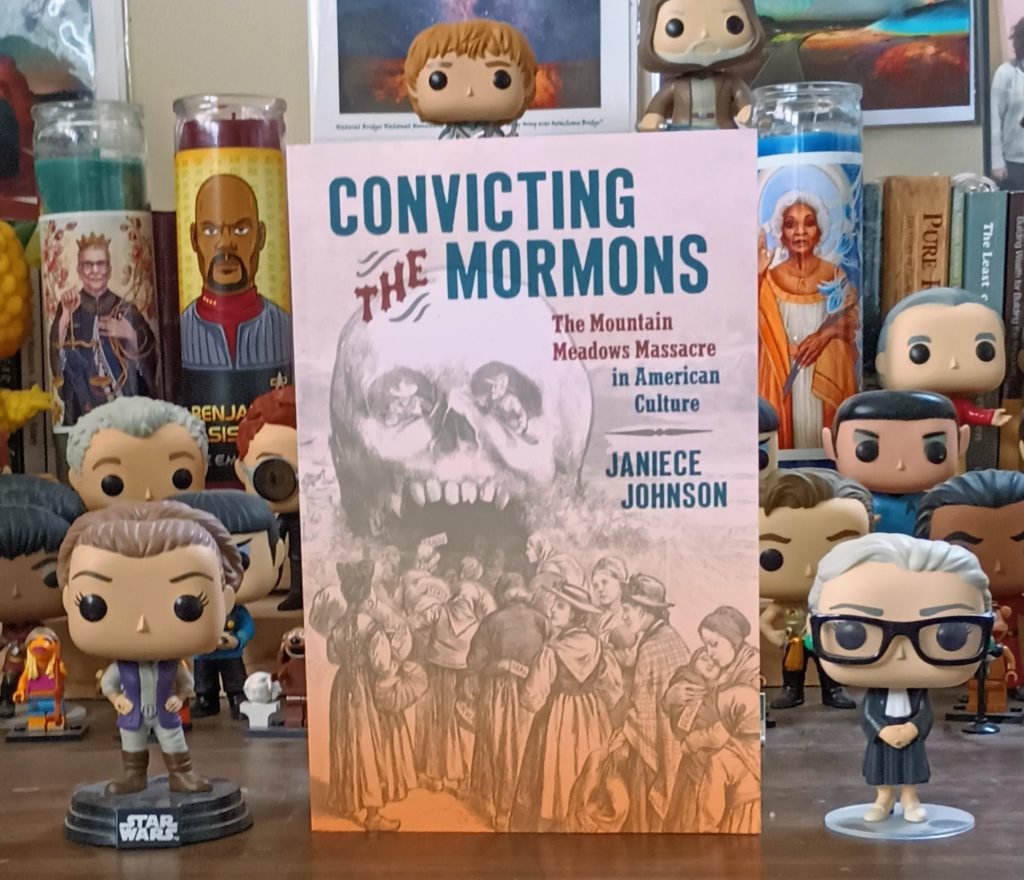Title: Convicting the Mormons: The Mountain Meadows Massacre in American Culture
Author: Janiece Johnson
Publisher: University of North Carolina Press
Year Published: 2023
Pages: 216
ISBN: 9781469673530
Genre: Religious History
Price: $29.95
Reviewed by Kevin Folkman for the Association for Mormon Letters
“Violence begets violence…rumor becomes historical fact.” This phrase from the closing chapter of Janiece Johnson’s book about public perceptions of the Mountain Meadows Massacre sums up an unfortunate reality. America is a violent nation, from its founding down to the present day. Mass shootings have become a weekly occurrence. The January 6th protest at our nation’s Capital turned into a violent assault. Government officials at all levels are the subject of threats of violence. Our nation’s history is full of extrajudicial violence, including the lynching of Blacks, forced displacement and massacres of Native Americans, and prejudice towards immigrant communities. Johnson’s Convicting the Mormons: The Mountain Meadows Massacre in American Culture traces how the Mountain Meadows tragedy in the history of the Church of Jesus Christ of Latter-day Saints has shaped public opinion towards the Mormon church and its members down to the present.
Previous books have dealt with the massacre at Mountain Meadows and the events that led to the 1857 murders of about one hundred emigrants on their way to California at the hands of the local Mormon militia and some Paiute Indians. Johnson briefly gives the facts of the massacre but devotes her book to showing how it was reported in the press and made its way into popular culture. Newspapers reported the rumors, which made their way into books, and later films, and other media. Accuracy was not always a consideration, and the stories played up the massacre’s most sensational aspects.
Johnson describes how American cultural norms played into the retelling, where “Savagery, Whiteness, manhood, and theocracy were all pressure points in this constructed rubric of civilization” (p 17). These concepts provide the framework of her book, with chapters describing in detail how each of these built on the general attitude of the American public towards the Mormon Problem.
In the popular press, it was not individuals who perpetrated the murders. The problem began at the top with Brigham Young and then filtered down through seemingly blindly obedient men. The massacre came just a few years after the public announcement of polygamy and at the height of fears of a Utah Territory in rebellion. Mormons were deemed part of a cancerous blot on America’s Manifest Destiny. The Southern Utah militia members were not real Americans. White American men, the narrative goes, would not have been in league with the Paiute Indians. They would not have abandoned their ideals of masculinity to murder other whites, nor would they have disguised themselves as Indians by painting their faces. They became, in the eyes of the rest of the United States and even Europe, a degenerate race. They failed at the basic responsibility of American manhood of protecting women and children. Additionally, Johnson writes, Mormon men became hyper-savages, more brutal in their atrocities than their Native American allies.
One of the most interesting ideas that Johnson presents is that justice was delayed and not fully served in the first prosecution of John D. Lee in 1875. Territorial prosecutors focused on trying to convict all of Mormonism. Lee was just a symptom of the greater problem of the Mormon church. Federal attorney John Baskin argued “The Mormon community down there were nothing but dumb cattle…they allowed themselves to be made vassals or slaves” (p 90). Baskin’s primary goal was not to convict Lee but to put Mormonism itself on trial. When that first trial ended in a hung jury, Baskin was not disappointed. Baskin deliberately calculated that such an outcome would force Congress to deal with the problems of Utah and Mormonism by enacting tougher laws.
Johnson traces how the specter of the Mountain Meadows Massacre continues on down through the present via books, film, and television. From Arthur Conan Doyle’s first Sherlock Holmes story, A Study in Scarlet to Netflix’s 2018 series Godless, elements of Mormon violence and the legacy of Mountain Meadows continue to play out in popular media.
Special note should be taken of the many reproductions of 19th-century newspaper illustrations, book covers, engravings, and other visual media that emphasize the perceived danger and “otherness” of the LDS church members in Utah.
For this reviewer, there were dual elements of pain and sorrow that Johnson’s Convicting the Mormons evoked. First, America’s 19th century was rife with violence against minorities, groups that could be easily defined as Others. The persecution and expulsion of Mormon settlers from Missouri in the 1830s follows a similar arc. At Mountain Meadows, otherwise decent men allowed themselves to be caught up in fiery rhetoric, painting the members of the Baker-Fancher train as enemies based on rumor and fear. Taken in context with driving Native Americans from their ancestral homelands, anti-Catholic violence, lynchings, and anti-immigrant sentiment, Mountain Meadows, although extreme, is strangely part and parcel of a violent century.
The second element is that many of these same sentiments are still with us in the 21st Century. White supremacy movements, anti-government rhetoric, discrimination against minorities, and fear-mongering by largely unrestrained social media outlets with no concerns for accuracy are not all that different from the 19th-century environment. Johnson’s Convicting the Mormons should help us recognize how susceptible our nation is to rumor, innuendo, and violence. Recognition can help us to try and find a better path forward from our deeply divided national consciousness.

